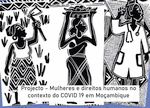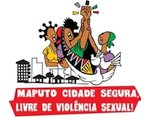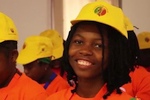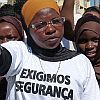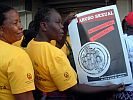Some Reflections on the Working of the Help Centres for Victims of Domestic Violence, 2000-2003
Conceição Osório1
In 1996, following the decisions adopted at the Women’s Conference in Beijing, the Mozambican government drew up an Action Programme against gender violence. Among the strategies defined, the Ministry of the Interior and Development was entrusted with carrying out a set of actions aimed at incorporating a gender perspective in each of its sectors, conducting curricular training in human rights and women’s human rights, increasing female police officers and creating Help Centres for Women and Children at police stations.
Help Centres for Women and Children
Created in 1999, the Help Centres for victims of domestic violence were an institutional response to the ever-present need, felt by women’s organisations, to provide a more effective support system for violence cases they handled.
During the 1990s, organisations aiming to provide legal assistance to victims helplessly watched the pain of victims and the arrogance and continued abuse of their aggressors, because they lacked legal means and instruments. While for some men the public visibility of their actions made them retreat from their violence, many others, when called upon to explain themselves by members of the organisations, would respond with more violence and rage against their victims.
Furthermore, police authorities, made up mostly of men, possessed neither the sensitivity nor the orientation to control violence against women, especially when it was committed in a domestic context. Many of the complaints made by women and referred to police stations were either lost in the jumble of cases considered as priorities, or the complaint was turned around, so that the aggressors became victims and the victims became culprits (“she asked for it”, “she’s the one who disobeyed me”).
Socialisation mechanisms impose a violent model of identity construction on men and on women, that is, the social practices and representations of women and men are formed through social relations, shaped by foundations that legitimise the sexist exercising of power. The actions of police officers should be understood, above all, in this sense: like most people, they think and live according to the predominant social norms; but by their functions, they learn to uphold the social order, and have a duty to act according to the law and constitutional principles.
In this duality between the social order (of which the family is a significant part) and the Fundamental Law lies the explanation for the actions both of victims and of police officers. By breaching the social constraints that prohibit them from publicising domestic violence, the complainants are threatening the model whereby conflicts between partners are kept private. At the same time, they are exercising their rights under the Constitution. Similarly, police action in response to the victims swings between defending the model in which they were socialised and the legal principles they are bound to uphold.
For this reason, and because there is no specific law against domestic violence, before the Help Centres were created police handling of victims was guided by the bases that dominate the cultural model, that is, the women who sought solutions to their problems at police stations were generally heard with an air of superiority and distaste. On the other hand, the women themselves often looked upon police stations as places of consolation and prevention (by reprimanding the aggressor) of further violence, and they did not wish (possibly for fear of the social consequences) to formalise the complaint.
Today, the Help Centres provide a space where, for the first time at the level of the State, women can present their complaints and have their rights upheld. The creation of these spaces at police stations has also made it possible for organisations of civil society, especially those providing legal assistance, to request police intervention whenever aggressors and lawbreakers refuse to appear. I think this is the first major victory of the Centres: they strengthen women’s rights organisations, to which the Centres and police officers have become an ally with the power to intervene and restore constitutional legality.
The second great victory is that, although women make up only 7% of police officers in active service, and only one of them is a senior officer, and 177 are subordinate officers, in an environment where 338 men are senior officers and 2695 are subordinate officers, women do constitute a group that has training, capacity and an awareness of the need to fight for equal rights for all. Today, throughout the country, with the exception of Inhambane and Zambézia provinces, there are 16 Help Centres for Women and Children who are victims of domestic violence. At these Centres victims can get real help, rebuild their self-esteem and say “enough violence”.
While the Centres play a central role in combating domestic violence, they are still constrained by a number of factors. Briefly, we will set out some of the main difficulties that interfere with the action of these centres.
The first factor is the small number of women working at police authorities and their low rank: the fact that the personnel staffing the Centres have low level positions in the professional hierarchy affects their capacity for decision making and for handling complicated and difficult situations, all the more so because what is at play is two different models of thought and of managing violence against women and children.
The second factor is the insufficiency of resources: although police stations on the whole are not endowed with sufficient resources, we noted that there is an urgent need to improve conditions at the Centres, in terms of both human and material resources. If they are to work effectively and respond swiftly to the diversity of situations that are brought to them, basic operating conditions are needed, such as a vehicle and a shelter-room for victims.
During our research, we witnessed the anguish of police officers that needed to transport victims to the hospital and/or give them a place to spend the night without fear of being attacked again. In addition, the opening hours of the Centres (with the exception of Beira) follow those of public offices; but international experience has shown that violence is most often exercised at night and on weekends, which means that the hours when victims are attended to need to be extended.
The third factor that the Help Centres have to contend with is the absence of a charter to clarify their operation, and also the lack of legislation that penalises domestic violence.
Because the Centres do not have a charter, they are in a situation of double subordination. On the one hand, the officers working there should be guided by local, regional and central coordination norms; and on the other, within the organisational framework of the police authorities they are subject to the station commander. This has led to a certain lack of autonomy and effectiveness in managing conflicts, particularly as regards the channelling of complaints, with the result that the Centres have (essentially) become places for listening and counselling.
These difficulties might frustrate the officers working in the Centres, since they depend on the greater or lesser degree of sensitivity of permanent officers and station commanders for the classification and channelling of cases of domestic violence.
The fourth factor is the elements of primary socialisation that influence representations and practices: many women (police officers or otherwise) and most men still think that women’s function is to be ruled by men, to cook for them, to handle their laundry and prepare their bath, and to give them children. A good woman is still a woman who lives for her husband and her children, one who, as the Mozambican women’s anthem says, produces and feeds the combatants.
These representations adversely affect the way a complaint is received and handled. Practices of officers are still dependent on the set of images that have been constructed during the course of their lives. For example, we noted that when a victim files a complaint, the prevailing practice is to provide counselling aimed at reconciliation, even when violence is ongoing and systematic. The choice of this solution is in keeping with the victims’ feelings of self-blame attitude, with a discourse of justification based on the economic dependence of women.
This duality in some ways reflects the conflict between the training given to the agents working in the Centres (and their revolt in the face of the violence against women) and the difficulties involved in breaking away from the mechanisms of socialisation. Possibly for this reason, only around 10% of the cases of violence against women are referred to PIC (the Criminal Investigation Police) and the courts, while 60% of complaints made by men against women are referred to higher authorities.
The fifth factor that constrains the operation of the Centres relates to the police stations’ institutional and internal interaction (or articulation). As regards forms of internal interaction, we encountered three different situations:
- The reception desks at stations refer victims of domestic violence directly to the Centres; here they are attended to, their aggressors are notified, and neighbours and neighbourhood structures are heard. But it is permanent officers who draw up the legal documents and proceedings, and the way the acts are classified and channelled depends on them. This situation has given rise to “deaf disputes”, which are normally resolved unfavourably for the Centres, given the low rank of the officers working there, and this contributes to discouraging victims from filing complaints.
- Victims of domestic violence are received by a permanent officer, who records, classifies and remits the case to the Centre (if he considers it is appropriate to do so), and the Centre then notifies the parties. For the case to be referred to PIC, it must first go through the permanent officer again, with notice to the commander.
- Victims of domestic violence approach the Centre, where legal proceedings are drawn up and channelled to other authorities, without the intervention of permanent officers, but with notice to the commander.
In terms of institutional interaction, once the legal documents are drawn up, less serious cases (summary proceedings the value of which does not exceed 100 million Meticais) are channelled directly to the courts, while cases requiring further investigation are referred to PIC. PIC is responsible for gathering evidence and remitting it to the Attorney General’s office and, finally, sending the cases to the courts for trial. It is in the process of channelling and referring cases that most difficulties arise, because the cases are not always accompanied by the proper documentation or material and they often lack incriminating evidence, with the result that the accused are released. This situation has led to friction between institutions and between institutions and the community2. In addition, there are serious problems within institutions, linked directly the development of cases, and reflected in cases being paralysed, delayed our filed away. This is so in cases of mistreatment of minors, where the Attorney General’s office is supposed to represent minors and is under an obligation to move for the punishment of the offenders. This frequently does not happen and the Attorney General’s office often “devolves” to other authorities cases that are entirely within its competence.
If the combination of these factors results in the Help Centres operating in different ways, that is, with regard to the classification and channelling of cases, we think that the social construction of violence, particularly domestic violence, is the key to understanding the constraints that affect police action.
When we talk about violence, we take into account, firstly, the successive reformulations that the concept has been subject to, especially over recent decades, and, secondly, the relationship between violence and gender.
Violence against women and human rights
The notion of violence was first used in relation to the concept of human rights during the 18th Century, in the sense that the violation of human rights was expressed as violence against the beneficiaries of those rights. This meant that the legal construction of violence was relevant only as regards particular persons designated as “having access to human rights”. Until the mid 20th Century3, this conception excluded from civil and political rights those persons who, by virtue of their race, social position and sex, were considered as non-citizens.
During the 1960s, 70s and 80s new rights, like cultural and economic rights, were integrated into the universal concept of human rights and particular groups of people, like women and children, became the subject of international conventions that defined and formulated instruments to protect their rights. However, the bipolarisation of the world into blocks and opposing systems of government allowed States to attribute legal value to human rights components according to their ideological nature. Thus, the West appropriated civil and political rights as those that constitute the matrix of the universality of human rights, while countries with socialist orientations adopted cultural, economic and social rights as the essential ones.
This bifurcation, corresponding to the deflection of human rights, expresses the divisibility of human beings and the subjection of their rights to political regimes. Only at the World Human Rights Conference in Vienna in 1993 were the indivisibility, interdependence and universality of human rights affirmed, putting human rights violations against liberties on an equal footing with those preventing human beings from living with dignity.
By emphasizing the indivisibility of human beings at the Vienna Conference, for the first time States and women’s organisations reflected, as regards women’s human rights, on the relationship and cohesion between private and public spaces. What was expressed at Vienna were not simply normative principles for the protection of women’s rights, but the need to evaluate and expose the deeper causes that throughout the ages have led to the silencing of and social complicity with violations of women’s rights.
This re-conceptualisation of human rights and in particular women’s human rights is, on the one hand, a legacy of the struggles of feminist movements and, on the other, a result of the theoretical works of academics. In this field, the work of Michel Foucault during the 60s and 70s, on sexuality and its relation to power, stands out. To this French sociologist, the body and the representations and practices linked to the body, are fruits of the social order and the dominant institutional and symbolic forms. That is, throughout the course of history, male and female sexuality has expressed the diversity, both normative and symbolic, of domination over women. This means that women’s bodies are at once the place where one can read how society thinks and defines the roles and functions of women, and a space for social control, which means that the body and sexuality are constrained by power mechanisms that shape a model of subordination/subalternity of women.
Like all other fields of social life, woman’s body, at the same time as it mediates the social and cultural orders, is subject to resistance strategies that conflict with the dominant practices and representations, allowing new elements to be introduced into the ways in which women’s roles are socially structured and shaped. I refer principally to the attempts to break down of the division between private and public. Put another way, it is recognised that the family is the producer of power while at the same time it is denied that the conflicts arising within the family space are private and remain invisible.
If this view of the family as the primary place where identities are constructed and power is produced permits the emergence of new approaches on a theoretical level, on a practical level it constitutes an opportunity for altering social relations conditioned by the sex-gender system. It is in this sense that we will analyse, in greater depth, the socialisation of women and men as a constraint on the functioning of Help Centres for women and children.
Help Centres and representations in respect of violence against women
As we have said, the Centres are spaces for counselling and legal assistance for victims of domestic violence. The need to create these structures has to do with the State’s ratification of the decisions taken at Beijing and with the involvement of women’s organisations in integrating a gender component into public policies.
Violence against women is considered as gender violence when its commission is associated with mechanisms that subordinate women in social spaces, that is, when violence against women is justified and supported by a model that organises social relations between men and women unequally.
For this reason, when we talk about gender violence we have to recognise the elements that structure domination over women in the construction of female and male identities. The family, as the first place of belonging, a place where feelings and reason interact and mix, expresses in an articulated way the values and norms that accord with the social order. Even when we distinguish different situations, like urban and rural or different classes, there are elements of social cohesion that are permanent, which we can call, in Weber’s sense, categorical imperatives. That is to say, independently of family contexts, there are permanent elements that permit the inclusion of families and each of their members into society. However, this does not preclude the emergence, temporary or otherwise, of new values or the reconstruction of old ones, which, generated in one or more fields of social life, may influence cohesion mechanisms.
In Mozambique, although family forms are differentiated, they have been subject, due to factors like civil war, poverty and population displacement, to a certain degree of unity in terms of their composition, structure and functioning. This unity, which calls into question the weight of kinship relations and the importance of traditional hierarchies in managing family conflicts, will influence the breaking down of the privatisation of family conflicts and give women access to public spaces, such as the Help Centres.
During our research, we found that an increasing number of women are approaching women’s organisations and police authorities to report domestic violence, including physical violence, verbal and behavioural humiliations, abandonment and non-provision of maintenance support. In our view, the visibility of violence against women is the result of a combination of factors, notably, denunciation and the mobilisation of women’s organisations towards the situation of the violation of women’s human rights in the country, and the weakening/re-composition of authority in the management of family conflicts. Public discourse about gender violence, led by women’s associations, demystifies the naturalisation of violence against women, which in some way allows them to break away from the control mechanisms (exercised at home) that encourage silence and transform the victim into a culprit, as used to happened more frequently before the creation of the Help Centres.
In addition, the mechanisms that used to govern the system of social relations in the family (from the occupation and rotation of positions in family hierarchies to the characterisation and management of conflicts) are subject to change, which change translates into the emergence of new sources of power. Changing the means of family cohesion may result in contradictory situations. Firstly, the provisions that guide conflict resolution through persons who have the legitimacy to do so within the family are shaken, and there arises the possibility of access to public authorities regulated by a normative order that claims to be “blind”. Secondly, with the organisation of the family being readjusted, male power may be reinforced. That is, with the old sources of power disappearing or weakening, man exercises control over the reproduction of women’s subordination, without the mediation of other actors.
Thus, there is an increase in public denunciation of violence, but there is also more and “new” violence. More, because as we have noted changes at the level of political, social and economic reality provoke rapid and violent conflicts between social and cultural models. New, because the previous mechanisms and forms of exercising power over women have been substituted or readjusted, but this does not mean that there has been a structural alteration in social relations between men and women.
In our research on the identification of cases of violence against women and children, our target group consisted of male and female police officers providing assistance at the Help Centres in police stations. For this reason, identification of the causes that led women to approach the centres was analysed using the discourse of police officers. Although the classification of complaints filed by women at police stations does not follow any common criteria, we found that the way that crimes are classified constitutes an important indicator for analysing representations of violence. Thus, while the non-existence of a law penalising domestic violence is one constraint on the classification of acts of violence as crimes, it is also important to take into account that the mechanisms that socialise women towards inequality are the bases for the permanence and legitimisation of gender violence.
The sex-gender system continues, in more or less evident ways, to guide the learning of rights and duties within families and to determine positions in the family hierarchy and shape the values and behaviours of each of the members. Thus, many male and female police officers classify domestic violence as a “social case”, and they include in this definition acts ranging from physical violence, abandonment of the home and paternal authority, that is, criminal acts which are punishable by law. The same was found in relation to rape of minors under the age of 12, living off immoral earnings and corruption of minors, committed by negotiation between the person committing the crime and the father or relatives of the victim.
This situation demonstrates the conflicts that still exist between socially learnt roles (and even between the different ways that education is transmitted and appropriated within the family) and the information brought by new knowledge, despite the human rights training administered to police officers. The tensions reflected in the way that violence against women is managed are, thus, simultaneously, the result of maintaining social gender relations of domination and the diversity of experiences and acquired knowledge.
Conflict management practices reveal the co-existence of contradictory representations: on the one hand, there is a perception that violence against women and children is the result of the inequality that shapes relationships between men and women and, on the other, that same inequality is reproduced in action. For example, during our field work, we found that counselling is the prevailing action for resolving complaints, which not only represents a response to women’s expectations when they approach the Centres, it is also in keeping with the perceptions held by those who manage complaints of domestic violence as a non-conflict.
In our view, if the Help Centres for women and children are going to be more effective, their mission has to be clearly established. It is evident that only continued practice ensures that the objectives and priorities of the Centres are consistent with the reasons for their being established in police stations. Upon defining women and children victims of domestic violence as their target group, these structures should seek to define the scope of their action, taking into account that they were created as part of the gender component of Ministry of Interior policy.
The objective behind the creation of special spaces to attend to women and children is the prevention and suppression of gender violence, that is, the Centres owe their existence not simply to the fact that women are the principal victims of violence, but principally because this violence corresponds to the model on which social relations between men and women are organised. It may be that, for example, the increasing use of the Centres by men reporting violence inflicted upon them by their female partners might lend weight to the argument that “everyone exercises violence, but women suffer more because of their physical weakness or economic and social dependence”. By failing to look in depth at the contexts in which domestic violence is committed against men (possibly a result of systematic and ongoing violence against their partners), the Centres may help to strip gender violence of meaning and transform it into a non-contextual concept of violence.
Giving women full responsibility for the situation of children is also evidence of the preservation of an image of women principally as mothers and wives. In this line, we cannot fail to relate two stories that took place at Help Centres. In the first story, a woman left her home, leaving the children in the care of her husband. The father worked during the day and the children were left to their own devices, which left them very under-nourished. The neighbours approached the Centre and the solution was to accuse the mother of abandoning the children and to seek her out to punish her. The second story concerned a child abandoned by its mother. Beside the child were a bundle with clothes and a letter explaining the reasons that led the mother to leave her child, which consisted of the fact that, after trying to find every means to sustain the baby, including asking for help from the child’s father’s family, she could find no other way but to “abandon” the child. Like in the other case, the solution of the Centre was to punish the woman, discharging the father of all responsibility for the child’s situation.
These two stories, which were discovered after the research was conducted, clearly demonstrate the need to continue to invest in training the police officers that provide the assistance, so that the Centres can become powerful instruments for the protection of women’s human rights. Only in this way can we hope to change the mechanisms on which social relations are based and which make men and women victims of a model that shapes and organises us into hierarchies based on inequality.
- This article discusses some of the results of WLSA Mozambique’s research.
- In cases of aggravated assault, persons are detained and referred to PIC, and in cases of simple assault, the proceedings are referred directly to the court.
- The Universal Declaration of Human Rights approved by the United Nations in 1948 raises, for the first time, the issue of equality and the universality of the human rights of peoples.







 Information in English
Information in English